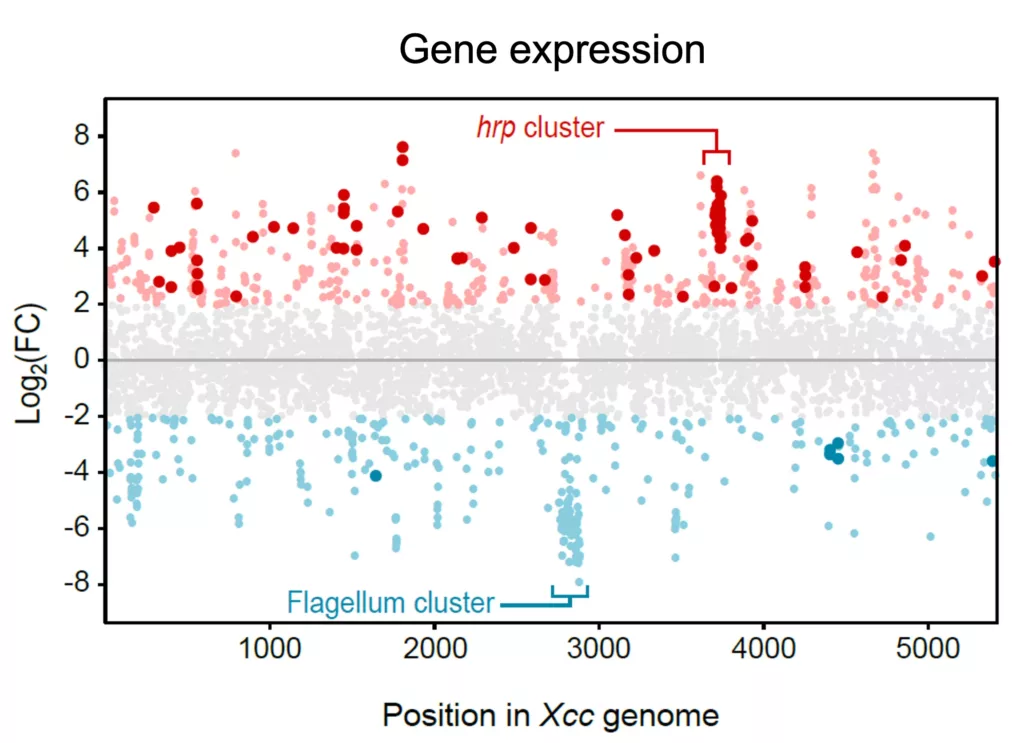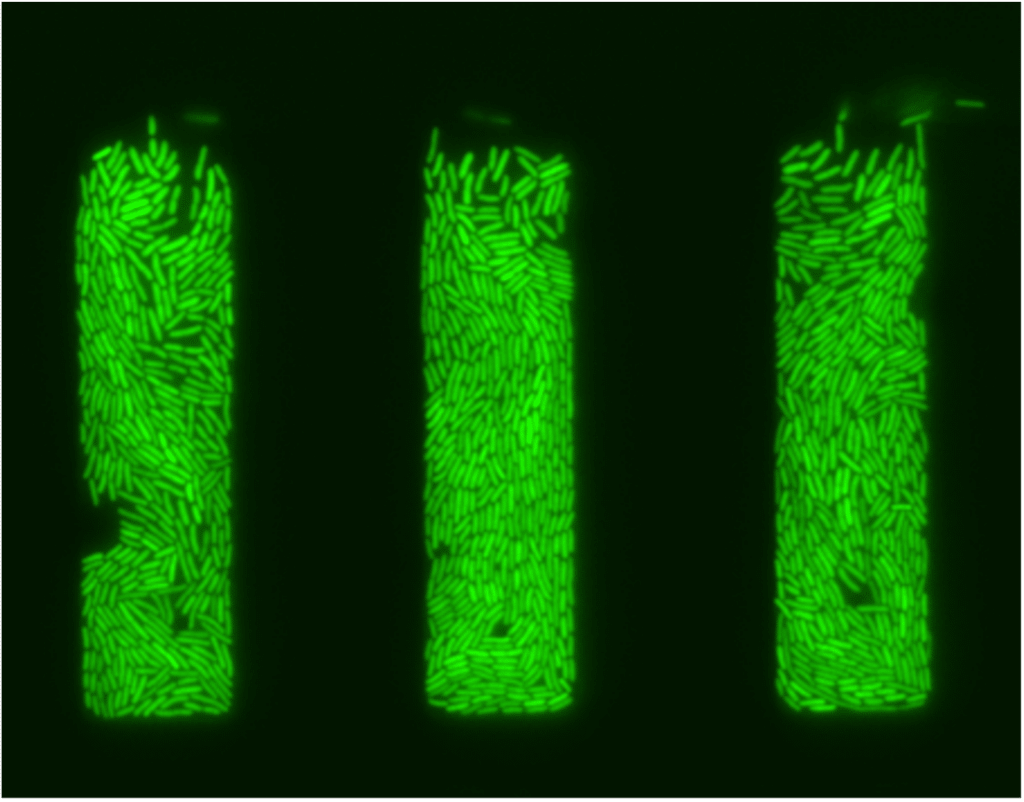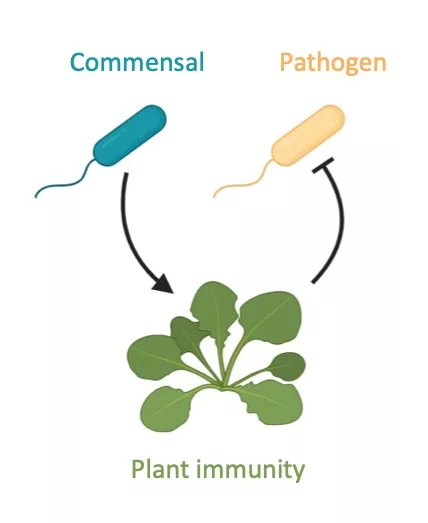Food production, both in quantity and quality, is one of the most pressing issues of humanity. However, pests and pathogens often drastically reduce crops yield. As we strive to control plant diseases, the development of new solutions requires a better understanding of plant-pathogen interactions, especially if we want to ensure the sustainability of agrosystems and their resilience to climate change.
I am a French agronomist who firmly believes that taking a systems biology approach to understand pathogen ecology and evolution – combining genomics, microscopy and population dynamics modelling – can help us solve the problem of plant diseases. I am particularly interested in understanding what happens during two critical, yet still enigmatic, phases of plant infection: (1) Upon early entry into the plant, as the outcome of early local interactions will determine if the pathogen can successfully establish and cause disease, and (2) during vascular infection, as xylem colonization leads to systemic spread of the pathogen and aggravation of disease symptoms.
Now, as a postdoc researcher in the groups of Sara Mitri (University of Lausanne) and Simon van Vliet (Biozentrum), my research focuses on understanding how local pathogen interactions with the microbiota, immunity and local abiotic environment in the plant lead to the emergence of complex behaviors. In a mutli-disciplinary approach, I combine microfluidics, time-lapse single-cell fluorescence microscopy, data analysis and mathematical modelling to investigate how collective behaviors and short-range pathogen-commensal-immunity interactions can influence pathogen establishment and disease.

Projects
In planta pathogen genomics
How do bacterial pathogens successfully establish upon entry into plant leaves?
We used in planta bacterial omics to explore bacterial strategies during the early infection steps.
First, we reasoned that pathogens would respond specifically to the leaf environment and adjust their transcriptome accordingly. Comparing the bacterial transcriptome upon early entry and late establishment time-points, we found that bacteria drastically turn down motility during colonization, induce high-affinity nutrients uptake, adjust metabolic activities towards catabolism of plant compounds and partially activate the production of virulence factors. This brought significant insights into the nutritional and stress status of the pathogen during early biotrophic and non-vascular infection stages.
Read more: Luneau, Cerutti et al. (2022) Molecular Plant Pathology

Then, we performed a genome-wide screening for genes directly contributing to pathogen growth in plant environments using an RB-TnSeq library of bacterial mutants. In addition to identifying over 350 essential genes, we confirmed the importance of several metabolic capacities, but of surprisingly few virulence factors, for growth in hydathodes and xylem sap. Interestingly, we noticed social behaviors occurring within our population of mutants, with bacteria lacking major virulence regulators displaying a competitive advantage and behaving as cheaters. This observation of social behaviors during plant infection fueled my interest for pathogen in-host ecology and evolution, which is now central to my projects.
Read more: Luneau et al. (2022) New Phytologist
As part of our study, we also developed a protocol for a competition assay measuring the relative fitness of mutant strains during plant infection: Luneau et al. (2022) Bio-protocol

Single-cell pathogen ecology (ongoing)
How does phenotypic heterogeneity emerge from local pathogen-environment interactions and contribute to disease?
While we know clonal populations of bacteria often exhibit heterogeneous phenotypes, the importance of heterogeneity for plant infection is completely unexplored. Here, we study the effect of environment variation as a source of phenotypic heterogeneity. We grow bacterial pathogens in microfluidic chambers and explore how gradients self-generated by bacterial activity and likely to occur in the plant (nutrients, toxins) can affect single-cell heterogeneity in the expression of virulence factors. Understanding the effect of micro-scale gradients on the behavior of bacterial populations will expose an additional layer of complexity that pathogens harness for successful plant infection.

Modelling pathogen-immunity-microbiota interactions (ongoing)
How can plant immunity activation by the microbiota lead to disease suppression?
Disease-suppressive properties of the microbiota have enormous potential for field applications. Here, we explore how local activation of immunity by commensal bacteria can prevent pathogen establishment in the plant. Using individual-based modelling, we simulate leaf infection by a bacterial pathogen alongside a non-pathogenic strain and study the conditions stopping or allowing plant colonization by the pathogen. In addition, we explore how immunosuppression by the pathogen can benefit commensal strains and lead to the co-existence sometimes observed in the field. Ultimately, we aim to find general principles in host-pathogen-microbiota interactions to guide the design of synthetic communities for disease control.

CV
Education | ||
| 2021 | Ph.D. in Plant-Microbes Interactions University of Toulouse, France | |
| 2017 | M.Sc. in Agronomy Engineering Agrocampus Ouest Rennes, France | |
Research Experience | ||
| From Jan 2023 | Postdoc | University of Lausanne, Switzerland Supervisors: Sara Mitri & Simon van Vliet Single-cell pathogen ecology & Modelling pathogen-immunity-microbiota interactions | |
| Sep 2021 – Dec 2022 | Postdoc | University of Lausanne, Switzerland Supervisor: Alma Dal Co Single-cell pathogen ecology under fluctuating environmental conditions | |
| Sep 2017 – Feb 2021 | PhD Thesis | Laboratory of Plant-Microbes-Environment Interactions, INRAE / CNRS / University of Toulouse, France Supervisors: Alice Boulanger & Emmanuelle Lauber Genome-wide identification of fitness determinants in Xanthomonas campestris during early plant infection | |
| Jan – June 2017 | MSc Thesis | INRAE Research Institute for Horticulture and Seeds, Angers, France Supervisors: Alexandre Degrave & Romain Warneys Mechanisms activated in apple by a Plant Defense Elicitor protecting against Erwinia amylovora | |
| July – August 2016 | MSc Student Internship | INRAE Fruit Biology & Pathology, Bordeaux, France Supervisor: Sylvie German Retana Interactions between plant and Potyvirus proteins for cell-to-cell movement | |
| Sep 2015 – Jan 2016 | MSc Student Intership | University of California, Riverside, USA Supervisor: Caroline Roper & Brian Engel Role of the Type II Secretion System in the virulence of Xylella fastidiosa on grapevine |